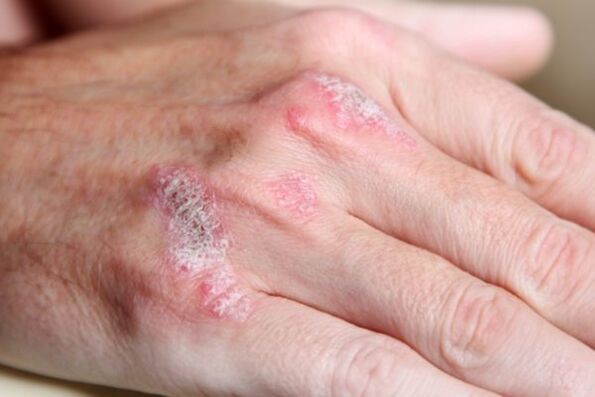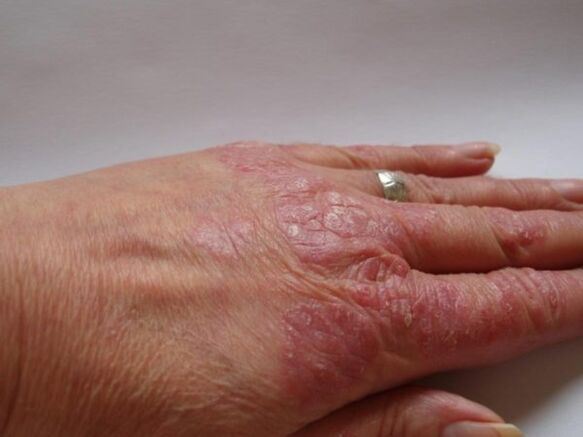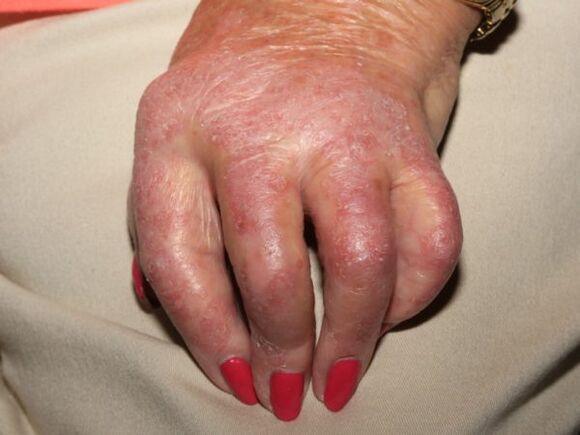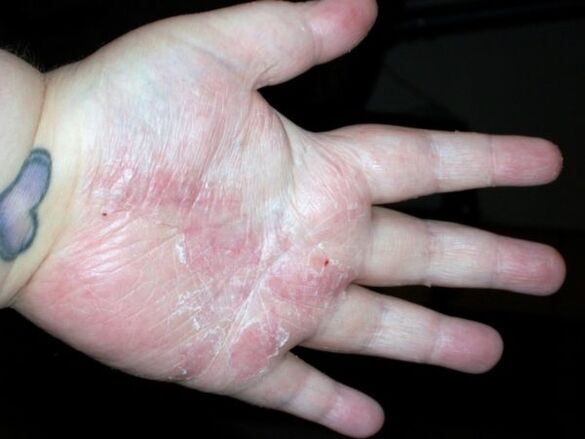Psoriasis is a chronic skin disease that cannot be completely cured. The disease requires symptomatic treatment to reduce the severity of manifestations and improve well-being. Psoriasis of the hands is a frequent localization of the pathology. It starts with the appearance of small plaques and can progress without proper treatment.

Causes and mechanism of development
Psoriatic plaques on the hands, especially on the fingers, significantly affect the quality of life. Although the disease is not contagious, strange skin blemishes are alarming. Psoriasis is not the most pleasant disease not only because it looks good, but also because of the risk of complications.
The exact etiology of the appearance of this dermatological disease has not been clarified. Experts identify risk factors that can affect the development of pathology. It is known that psoriasis is not transmitted through contact, nor can it be transmitted through contact with a patient.
It is also important that it cannot be completely cured, so a person is forced to take supportive care and monitor the condition of the skin at different times of the year. Frequent flare-ups occur in spring and winter. Scientists attribute the development of the disease to the following factors:
- genetic predisposition;
- immune deficiency, decreased protective function of the body;
- frequent skin lesions of viral, fungal, bacterial origin;
- sharp changes in climatic conditions;
- chronic skin diseases, including congenital anomalies;
- long-term use of certain medications, especially anticonvulsants, antidepressants and steroid hormones;
- psycho-emotional overload;
- metabolic disorders in the body.
Psoriatic plaques on the hands begin to appear in the area of small joints, between the fingers, near the phalanges. Pathological elements are more visible on the surface of the palm. Psoriasis of this localization is the most difficult to treat, because the hands are often in contact with household chemicals and other irritants.

Risk group
The risk group for the development of the disease includes men and women who are frequently exposed to other dermatological diseases. The likelihood of the disease increases when there is already psoriasis in the family.
Pathology can occur in people with weakened immunity, living in unsatisfactory living conditions. The risk group also includes those who have to come into contact with aggressive chemicals due to their activities.
Clinical manifestations
The first signs in the early stages of the disease will be the only pathological elements in the hands. The plaques may appear on the hands, fingers, and palms. If the nails are involved in a pathological process, there is a risk of loss of sensitivity and the appearance of tissue edema.
Increased dryness of the skin causes cracks in the palms. There are signs of thickening of the callus-like epidermis.

The main manifestations of psoriasis on the hands will be:
- increased dryness, redness of the skin;
- thickening of the epidermis, increase in the volume of the fingers due to edema;
- Cracking when the board cracks
- sometimes there is a combination of several elements that damage healthy skin.
In winter and autumn, when cold days prevail, the disease manifests itself as intense peeling of the skin. If left untreated, the hands are more likely to scratch with an infection, and then the symptoms are complemented by signs of inflammation.
Forms of pathology

Psoriasis on the hands can take several forms:
- On the fingers. Peeling is often manifested by the formation of inflamed plaques. Complications occur in winter. It often causes complications.
- On the brushes. It occurs in 25% of patients, the symptoms are similar to psoriasis on the fingers, the skin in the affected area becomes rough, red areas appear. The patient complains of constant discomfort, active peeling, itching.
- Palmar-plantar. It is found in people engaged in heavy physical labor. Heels and palms are affected. Rough areas of skin look like hard calluses and often have cracks.
- Arthropathic. Psoriasis occurs against the background of joint damage. The elements of the spill are located in the phalanges. In addition to external manifestations, the patient is concerned about joint pain during movement and then at rest.
- Pustules. The palms and soles of the feet are affected. Stress and hormonal pathologies become risk factors. The rash has clear borders and pustules are visible. The disease recurs frequently and is difficult to treat.

Each form of the disease progresses in three successive stages - primary, progressive and inpatient. After a period (after 3 stages) the disease begins to decline. At this stage, the clinical symptoms almost completely disappear. Treatment aims to prolong the regression phase as much as possible, otherwise the disease cycle will recur.
Differential diagnosis
It is characterized by pathologies such as psoriasis on the hands, lichen planus, Reiter's disease, syphilis, seborrheic and atopic dermatitis.
The main symptom of psoriasis during the examination will be a psoriatic trio, which can be prescribed by a doctor. These include stearin stain, punctate hemorrhage, and terminal film events.
Methods of treatment
Although psoriasis cannot be completely cured, it must be treated to prevent complications and improve quality of life.
The main measures for the treatment of psoriasis on the hands:
- use of care products to moisturize and soften the skin;
- to take antihistamines to relieve itching;
- to take medication to increase immunity;
- additional use of homeopathic remedies.
Physiotherapy and photochemotherapy may be prescribed for psoriatic lesions. When psoriasis is accompanied by joint disease, painkillers from the group of non-steroidal anti-inflammatory drugs are used.
Depending on the stage of the disease, the dermatologist will prescribe local anti-inflammatory drugs. May contain salicylic, ichthyol, sulfur resins. Hormonal ointments can be used to quickly relieve the symptoms of severe itching, can not be used without a doctor's permission.
You can use herbal baby creams for sensitive skin to soften and moisturize.
Prevention measures
General preventive measures to prevent exacerbation of psoriasis on the hands:
- use of rubber gloves when cleaning the house when it is necessary to come into contact with detergents and cleaning agents;
- giving up bad habits, sleeping well and eating a balanced diet;
- daily skin care using natural cosmetics or medicines;
- take regular sunbathing, ventilate the house often, walk in the fresh air, avoid stress;
- in case of accidental damage, treat the skin with antiseptic (it is not recommended to bandage the wound for a long time);
- Follow the Pegano diet, which restricts meat dishes, sweets, and adds more grains, vegetables, and herbs to the diet.
Disease prognosis
Unpleasant psoriatic rashes on the hands are stressful for many patients. At the same time, the experiments aggravate the situation. Psoriasis can be delayed for a long time, but for this you need to follow the therapeutic and prophylactic measures prescribed by your doctor.
It is impossible to get rid of psoriasis completely, but proper skin care, diet and use of special creams will hide the symptoms of the disease as much as possible. Regardless of the manifestations of the disease, it is recommended to visit a dermatologist every few months to monitor the dynamics of the disease and, if necessary, adjust the treatment regimen.























